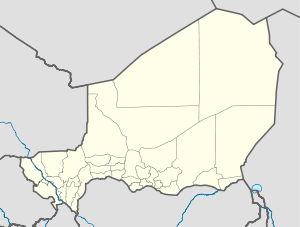Dogondoutchi
| Dogondoutchi | |
|---|---|
| Location of Dogondoutchi | |
| Coordinates: 13°38′46″N 4°01′44″E / 13.64611°N 4.02889°E | |
| Country | Niger |
| Region | Dosso Department |
| Department | Dogondoutchi Department |
| Commune | Dogondoutchi |
| Elevation | 227 m (758 ft) |
| Population (2011) | |
| • Total | 79,389 |
The urban community of Dongondoutchi ("High Hill"), also nicknamed Doutchi, is located about 300 km east of Niamey the capital of Niger and 40 km from the Nigerian border. It lies on national route 1 which links the capital to the towns of Maradi and Zinder to the east and the RN25 heading to north to Tahoua, Agadez and Arlit. The limits of the Dogondoutchi district are roughly those of the ancient region of the Arewa. Since 2008, Dogondoutchi is the administrative centre of the surrounding Dogondoutchi department which carries the same name. It is part of the Dosso Region. The population is near 80 000 distributed over the urban centre with near 30 000, 17 villages lying 5 to 30 km from the centre and 5 Fula tribes.
The town of Dogondoutchi is dominated to the north by the imposing hill from which it derives its name and it lies along an intermittent river the Mawri Dallol. It is situated in the South East of Niger between the Sahel to the north and the edge of the savanna zone to the south.
The region is marked by wide valleys (Dallols) which are generally dry and which, in the rainy season, drain a vast area extending from high areas of the Aïr and the Adrar de Iforas in the north to the River Niger in the south. In this sedimentary basin there are extensive sand and clay deposits, the most recent dating from the Tertiary and Quaternary periods. As a result of a later dryer climate during the quaternary period, they hardened to form impermeable lateritic plateaus worn down to form a multitude of short ravines (koris) through which the rain water reaches the Mawri Dallol.
The annual rainfall in Dogondoutchi varies from 400 to 600 mm, roughly equivalent to that of the Mediterranean region in France but it takes place only between June and October and there is never any rain from October to May. The rainfall may be very intense – 50, to 150 mm a day, which leads to flash floods causing structural damage to the dry clay (so-called banco) houses along the koris and carrying off arable soil. The water is rapidly absorbed into the underground water layers or it reaches ponds which either dry out after the end of the rainy season or remain semi permanent (for example the Tapkin Saw close to the town). Following the catastrophic floods of 2002 the inhabitants, in association with international aide and the United Nations "Food For Work" Programme, constructed five kilometres of dykes which now protect the town. The experience gained during this operation has served in other parts of Niger and in Mali thanks to the Niger NGO "RAIL"
...
Wikipedia

